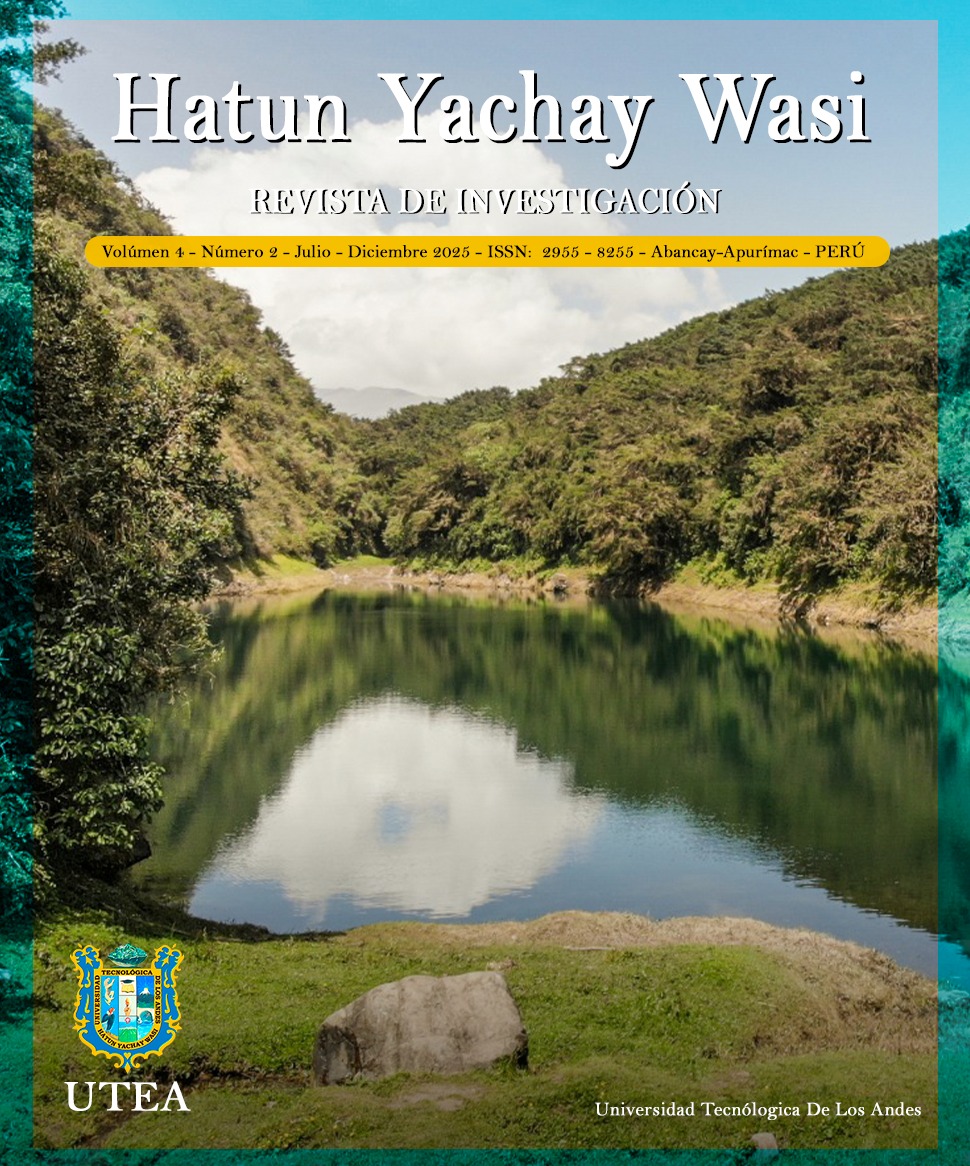Evaluation of soil infiltration capacity with forest plantations of Pinus radiata and Polylepis spp. at Laguna Rontoccocha, Abancay, Peru
Main Article Content
Abstract
Infiltration is considered a significant component of the hydrological cycle, a good indicator of soil quality and health, and recharges aquifers. The aim of this study was to evaluate the infiltration capacity of soil planted with Pinus radiata and Polylepis spp. in Rontoccocha Lagoon, Abancay, Peru. The population consisted of soil with forest cover of Pinus radiata and Polylepis spp. The samples were four plots in soils with Pinus radiata and in soils with Polylepis spp. Soil physicochemical parameters (humidity, bulk density (AD), pH, texture and organic matter), infiltration rate, accumulated depth and infiltration capacity (Horton equation) were determined. Minitab was used, and the student t-test, Mann-Whitney, and simple regression analyses were applied, with a statistical significance value (p < 0.05). The results showed 0.95, 12.54%, sandy loam, and 11.24% vs. 0.60, 46.55%, loamy sand, and 56.59% for AD, moisture, texture, and organic matter. Both soils are acidic with a high level of sand and little silt and clay. The average infiltration rate was 74.63 cm/h (Polylepis spp.) and 20.48 cm/h (Pinus radiata), with a significant difference. The average infiltration capacity was 17.63 cm/h vs. 44.12 cm/h for Pinus radiata and Polylepis spp., respectively. There was a high positive correlation in the linear regression analysis for both soils during the sampling months.
Forest cover positively affects the soil infiltration process due to its root systems, vegetation layer, and high organic matter, which greatly improves soil macroporosity.
Downloads
Article Details

This work is licensed under a Creative Commons Attribution 4.0 International License.
References
Alvarado, C., & Barahona, M. (2017). Comparación de tres métodos de infiltración para calcular el balance hídrico del suelo, en la Cuenca del río Suquiapa, El Salvador. Cuadernos de Investigación UNED, 9(1), 23-33. http://www.scielo.sa.cr/scielo.php?script=sci_arttext&pid=S1659-42662017000100023&lng=en.
Béjar, S., Cantú, I., Yáñez, M., & Luna, E. (2021). Evaluación y predicción de la infiltración en un Andosol bajo diferentes usos de suelo. Revista Mexicana de Ciencias Agrícolas, 12(7),1171-1183. .https://doi.org/10.29312/remexca.v12i7.2327
Bosques Andinos (s.f). Los bosques Andinos y el Cambio Climático. https://www.bosquesandinos.org/los-bosques-andinos/https://www.bosquesandinos.org/los-bosques-andinos/
Cervantes, R., Sánchez, J., Alegre, J., Rendón, E., Baiker, J., Locatelli, B., & Bonnesoeur, V. (2021). Contribución de los ecosistemas altoandinos en la provisión del servicio ecosistémico de regulación hídrica Ecología Aplicada, 20(2), 137-146. DOI: https://doi.org/10.21704/rea.v20i2.1804
Delgado, M., Gaspari, J., & Senisterra, G. (2017). Respuesta a la infiltración en distintos complejos suelo-vegetación en las sierras de Ventania, Argentina. Revista de Tecnología,16(1), DOI: https://doi.org/10.18270/rt.v16i1.2322
Espinoza, M., & López, F. (2024). Influencia del uso del suelo en los niveles estáticos de pozos de la microcuenca del río La Carreta, San Juan de Cinco Pinos, Chinandega, Nicaragua. La Calera, 24, 42. DOI: https://doi.org/10.5377/calera.v24i42.18141
FAO (s/f). Capítulo 2. Hidrología, arquitectura del suelo y movimiento del agua. https://www.fao.org/4/y4690s/y4690s06.htm
FAO (2021). Evaluación de los recursos forestales mundiales 2020 - Informe principal. Roma. https://doi.org/10.4060/ca9825es
Lozano, S., Olazo, J., Pérez, M, Castañeda, E., Díaz, G., & Santiago, G. (2020). Infiltración y escurrimiento de agua en suelos de una cuenca en el sur de México. Terra Latinoamericana, 38(1), 57-66. https://doi.org/10.28940/terra.v38i1.443
Mwendwa, S. (2022). Revisiting soil texture analysis: Practices towards a more accurate Bouyoucos method. Heliyon, 8, https://doi.org/10.1016/j.heliyon.2022.e09395
Muñoz, Y., Opolenko, V., Barahona, H., Fábrega, J., & Cedeño, A. (26-29 de septiembre de 2023). Caracterización del suelo y su relación con el proceso de infiltración. XIX Congreso Nacional de Ciencia y Tecnología – APANAC. Panamá, Panamá.
Superintendencia Nacional de Servicios de Saneamiento (SUNASS). (2014). Estudio Tarifario: Determinación de la fórmula tarifaria, estructura tarifaria y metas de gestión aplicable a la empresa municipal de servicio de agua potable y alcantarillado de Abancay Emusap Abancay S.A.C. https://cdn.www.gob.pe/uploads/document/file/6766266/5864417-proyecto-de-estudio-tarifario-de-emusap-abancay-s-a-c.pdf
Tapia, R., Carmona, J., & Martinelli, M. (2022). Evaluación de la infiltración en dos complejos suelo-vegetación en el Monte de San Juan (Argentina). Boletín de la Sociedad de Botánica de Argentina, 57 (4), 760-784. DOI: https://doi.org/10.31055/1851.2372.v57.n4.36882
Yaguache, L. (2022). Humedad y almacenamiento de agua en el suelo en cuatro tipos de cobertura vegetal. Ciencia y Tecnología UTEQ, 15(1), 19-24. DOI: https://doi.org/10.18779/cyt.v15i1
Yáñez, F., Hermoza, R., & Bazán, L. (2017). Caracterización de la infiltración de agua en tres sistemas de uso del suelo de la Comunidad Santiago de Carampoma, Huarochirí, Lima. Anales Científicos, 78 (2): 191-199. DOI: http://dx.doi.org/10.21704/ac.v78i2.1056
Zhu, Y., Sun, L., Jamshidi, A., Liu, X., Zheng, L., & Fan, Z. (2025). Effect of changing from natural forest to economic forest on soil water infiltration and its underlying mechanisms. Journal of Hydrology: Regional Studies, 59, 102351. https://doi.org/10.1016/j.ejrh.2025.102351.




